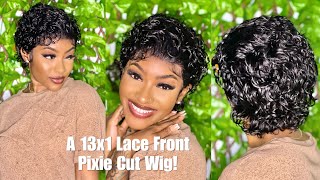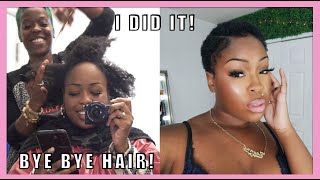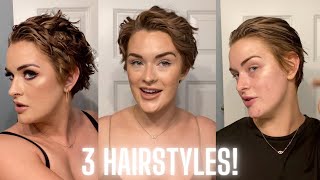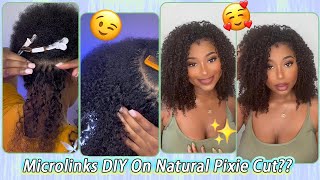Pixie Cut For Black Women Tutorial
- Posted on 29 September, 2019
- Pixie
- By Anonymous
A step by Step Pixie Cut for Black Women Tutorial.
Comment like share and subscribe "HAIRCUTS": https://tinyurl.com/yxl63md4
Tranquil by Lahar https://soundcloud.com/musicbylahar
Creative Commons — Attribution 3.0 Unported — CC BY 3.0
Free Download / Stream: https://bit.ly/_tranquil
Music promoted by Audio Library https://youtu.be/pHs_JPoDUHo
Alright guys so sectioning for this cut is pretty simple, just taking out the mohawk section and then drawing a line down the division point of the head. So right above the ear, it's really just separating the front in the back, then I go through and I blow-dry working back and forth with the comb almost doing pretty much a flat RAF blow-dry to smooth the back of the hair and then I'm gon na go Through with my Clipper, this is the andis supras er that I've done a review on. So if you guys want to check that out, you can see that in a past video, but I'm using a number 4 attachment on that clipper and the triple 0 blade on the Clipper as well and just going through scooping the hair out. So I'm starting close to the scalp and I'm working my way out as I get past, the occipital bone just to build up a little bit of weight in the crown area, and this is really just removing the bulk and what I want you guys to know About this haircut and the technique that we're doing today is we're gon na use multiple tools to create our end result. I think that a lot of people and I've talked about this before, but a lot of people get caught up in the fact that if they start a haircut with scissors, they have to finish it with scissors. I believe that you have multiple tools for a reason, so the Clipper goes through and it takes out the bulk very quickly and then I go through with with my scissor over comb knot to make it more perfect what I do with my scissor over comb. Is it gives it a little more of a natural feel where a clipper gives it more of a machine feel alright, so working the scissor over comb all the way up, keeping that weight in the crown? That'S a big key area to this haircut, making sure that you keep the head shape nice and balanced. So now, I'm gon na go through and I'm gon na wet the sides down and I'm gon na work vertically out. So this is where I want to bring in the head shapes, so you guys can see the head sheets. I guess I should say, and I'm working vertically straight out from the head. What that's gon na do is give me a little bit of weight towards the parietal Ridge, so you can see where that the elevation is lower toward Bridal Ridge and it's pretty much a straight out 90 degrees throughout the rest of this section. I'M holding in my hand, everything's going to the previous, so this is a traveling guide. I'M not trying to build up too much extra weight in the front of the head. If you wanted to you, could you just need to understand why that's happening so over directing everything's straight out back to the previous section, it's growing a little bit of weight, but not too much and then the very front. Everything comes straight out to me, which will give me a little extra weight which I'll deal with in the dry portion of the cut. So this is where I cut it wet now. I'M gon na blow it dry and I'm gon na do more detail work. So I'm taking it one section at a time and pretty much finishing those sections we're gon na use the tip of our scissor to work around the ear. If this was a real human, I would probably fold the ear down with my finger and cut around it. But I'm working that steady blade around the ear and around the hairline. So now we're working our way up the hairline and removing that weight that we pushed forward. So, like I've said in many videos in the past that sometimes I push weight forward to give me that solid line in the front. Now, if you don't like that solid line, you can always go in and just cut more of a PC hairline. If you like that, look better, I like the solid line right now I like having that solid shape with the messy texture on top. So that's what we're going for today so going through same thing, so most of the weight is sitting up at the parietal Ridge. Everything is coming straight out and slightly back to the previous section, and I'm just scooping the hair, so you'll notice that I always want to be combing the hair the same. This is one of the biggest mistakes that you'll see people making in haircutting is that they're combing isn't consistent. I combed the hair away from the face on the other side. So now, on this side, I'm combing the hair away from the face as well. I want to keep that consistency throughout the haircut, so just over directing you back, that's gon na push a slight bit of weight towards the front. You can see there now I blow it dry and then I'll go through and do my dry detail work. Keeping consistency within my haircut to get the best result so just using that tip of that scissor, drawing whatever line I want. So if they want to leave a little bit of length around the ear, you can do that. That'S what's great about over direction and elevation and all that stuff you're putting weight where you want it, and then you can remove it later so going through taking out that hairline drawing that nice solid line in there. Now we talked about using multiple tools. This is why now I'm going to go in with my trimmer, so I got the line that I wanted now, I'm just detailing it even more. A trimmer is just like using a scissor. It'S just a clipper has multiple blades on it, as opposed to a scissor, which is one blade, so you're gon na get a more solid line. If that's the effect you're looking for, then you go in with the trimmer. If you like, the way that this is or looks thing stick with that now, I'm just dusting around the edges you'll see kind of how that smoothes out the edges of the haircut. This is just another detail, a technique that I like to do with the trimmer on my shorter haircuts, men's cuts short women's cuts. It works really well to kind of define it. You look at how how we cut hair, we usually lift it up to create a shape. Well, naturally, the hairs gon na lay down when you have that shape. So if you run the Clipper over top of it, you're actually kind of itching in that shape. Even more so just a cool technique to try out now, I'm gon na go through I'm gon na work, the round of the head working from short to longer in more of a triangle fashion. So you can see why don't you look at the either the bottom left hand, corner diagram or the top right hand corner which is going to show you that we're cutting our guide from the side point that we had before and just going through, but I'm using A point cutting technique now because I want have a little more versatility, a little more texture in the top. This is my DB 20 scissor before just so you guys. So I give you a tool breakdown. We used the blacksmith's fit six and a half inch deserver scissor over comb. This is the DB 20 Mizutani scissor, it's a 5.7 inch. This is my go-to scissor is for precision, cutting or wet cutting pretty much in the salon so going through doing the point. Cutting not over directing anything too far back. The only thing I really over dragged back is the very front portion. I know I'm wearing black. I know she has black hair. It'S just kind of how this video worked out so you're having trouble figuring out the angle. Look at the diagrams that we have so just now. I also talked about consistent combing you'll notice that I'm combing the hair back towards me. The entire time so just make sure that any time you're cutting hair you're consistently combing, because if I were to comb one side back towards me, the other side forward. I'M gon na get different lengths within the haircut so just going through over directing it back to the previous. So it's a traveling guide and then at the very end I just over direct it a little bit more back just to push a little extra weight to the front, because I want to cut into the front in a different way. So that will make sense in a couple seconds. There'S that lone piece of hair again, so we go through finish up the point - cut right in the front of the head: it's not looking like much now, but I'm gon na go through and I'm gon na blow dry it. This is the three three eight YS part comb and just so you guys remember: all of these tools are available on free salon, education com. So, if you're looking to upgrade your tools, we have everything that I'm using alright. So I take the DB 20 scissor and I just do a little bit of slide cutting into the bang area, just to add a little bit of separation and and take the length a little bit shorter. So just deciding how much texture I want to put into the front of the hair, now we're gon na take our visit on e type, Z, dual scissor and just slide through the top working at a diagonal. A lot of people do this with a scissor, but I just find doing it with the texture. Scissor is a little bit, has a little bit more safety to it and also just removes the bulk that you're looking for not really cutting too many lines in the haircut. So that's pretty much the end of the cut. What I'm going to do is go through at the blow-dryer just to add a little bit of volume to it and I go in with Brocato carve and add the texture. It'S really just like a cream wax that I use on a lot of shorter hair cuts. So I'm going through just piecing that out with my fingers, and that is the end result of the haircut hope you guys enjoy this haircut. Definitely let me know in the comments below thanks you





Comments
HAIRCUTS: Did you find this tutorial helpful and useful?
Angela Day: Wow... I am going to cut my hair now. Thanks, for not using profanity. I really appreciate this video. You didn't go so fast, that I couldn't keep up. GOD Bless you!